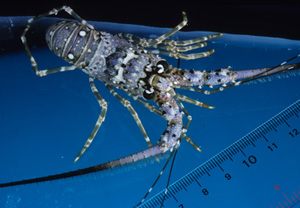Crustaceans
 Susan Laramore, Ph.D.
Susan Laramore, Ph.D.
Assistant Research Professor
772-242-2525
slaramo1@fau.edu
Some of the earliest crustacean research at FAU Harbor Branch explored polyculture of shrimp and lobsters with macroalgae as a potential means of mitigating the growth of epiphytes and epizoa on the seaweeds and minimizing feed costs for the animals. The mid-1980s saw spawning and culture studies of the Caribbean king crab and post-larval spiny lobsters toward the goal of growing the species to market size, and later included evaluation of spiny lobster vocalizations. In the 1990s, crustacean work expanded to encompass culture studies of ornamental and broodstock shrimp, and of Pacific white shrimp in freshwater.
The Pacific white shrimp is part of present-day studies of land-based multi-trophic aquaculture (IMTA) as a means of optimizing the sustainability and output of aquaculture. The recirculating system under investigation includes a shrimp biofloc system, which is intended to yield shrimp as an IMTA system product and, in the microbial flocs produced by the shrimp system, food for extractive species such as oysters and sea urchins.
